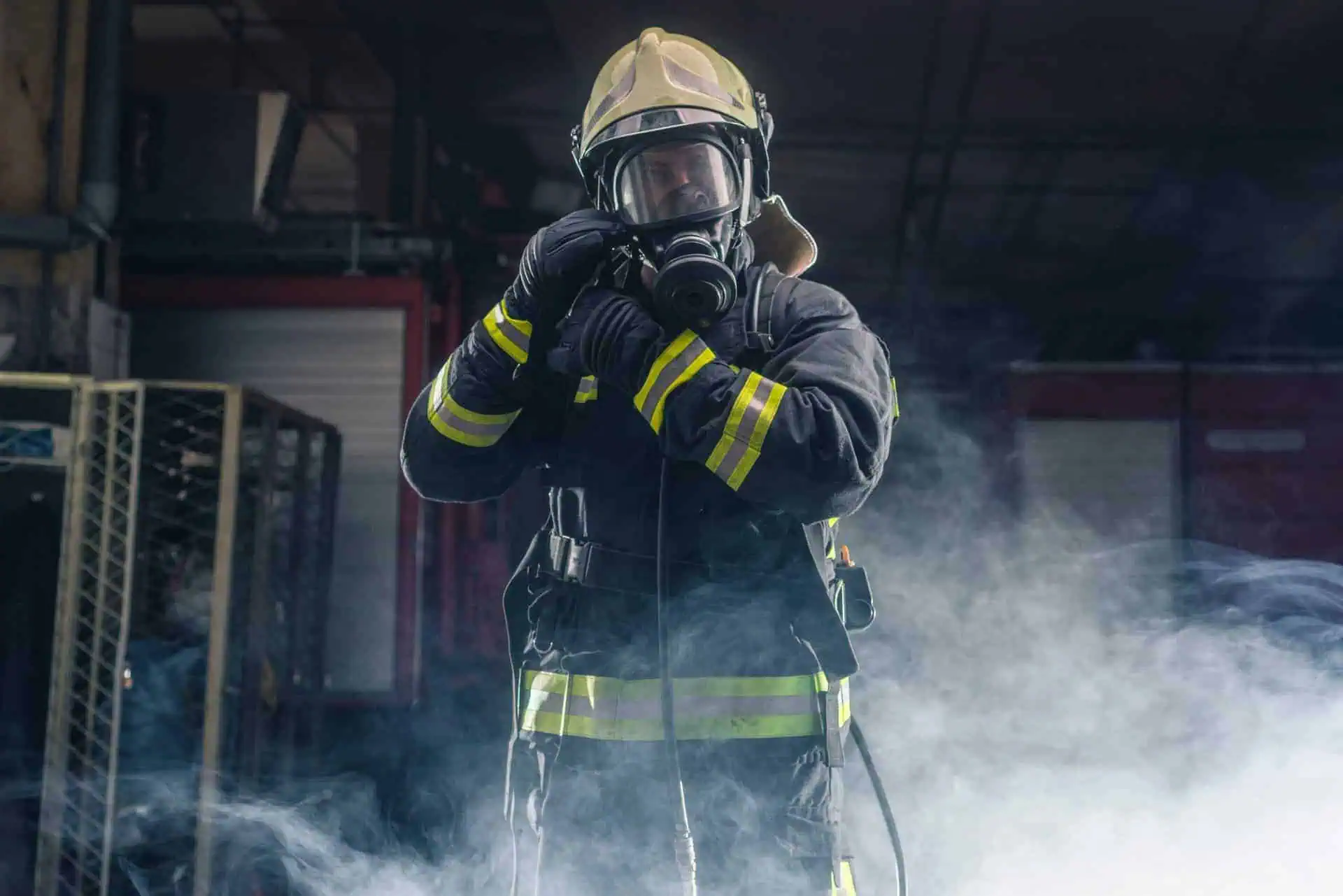PFAS Firefighting Gear Ban: Types of Turnout Gear
- Last Updated: July 14th, 2025

Attorney Jessica Paluch-Hoerman, founder of TruLaw, has over 28 years of experience as a personal injury and mass tort attorney, and previously worked as an international tax attorney at Deloitte. Jessie collaborates with attorneys nationwide — enabling her to share reliable, up-to-date legal information with our readers.
Legally Reviewed
This article has been written and reviewed for legal accuracy and clarity by the team of writers and legal experts at TruLaw and is as accurate as possible. This content should not be taken as legal advice from an attorney. If you would like to learn more about our owner and experienced injury lawyer, Jessie Paluch, you can do so here.
Fact-Checked
TruLaw does everything possible to make sure the information in this article is up to date and accurate. If you need specific legal advice about your case, contact us by using the chat on the bottom of this page. This article should not be taken as advice from an attorney.
Key takeaways:
- Efforts to remove PFAS, also known as forever chemicals, from firefighting gear have been unsuccessful. This highlights the need for continued advocacy, collaboration with regulatory bodies, and the development of safer alternatives that meet necessary safety standards.
- Studies have measured PFAS concentrations in firefighter's protective clothing, which includes turnout gear, finding the highest levels in the moisture barrier layer.
- To minimize the risks associated with PFAS in turnout gear, firefighters should take preventative measures such as only wearing gear when essential, treating PPE with respect, keeping gear separate from living areas, and washing gear before wearing it.
Overview of PFAS Firefighting Gear Ban
On this page, we’ll discuss banning PFAS firefighting gear, challenges implementing the PFAS firefighting gear ban, exploring alternatives to PFAS in firefighting gear, and much more.
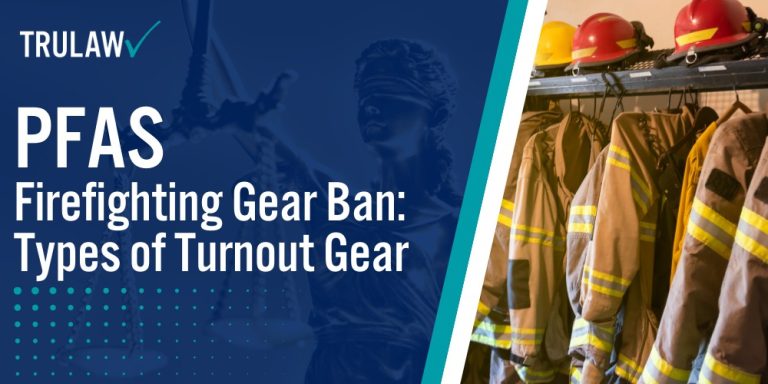
Intro to PFAS Firefighting Gear
The key concerns surrounding PFAS in firefighting gear include, but are not limited to:
- Presence of PFAS: Many firefighting gear and equipment, such as turnout gear and firefighting foam, have been found to contain PFAS chemicals.
- Health Risks: Exposure to PFAS has been linked to various health issues, including certain cancers, immune system dysfunction, and endocrine disruption.
- Occupational Exposure: Firefighters face a higher risk of PFAS exposure due to frequent contact with PFAS-containing gear and equipment.
- Contamination and Spread: PFAS can contaminate firefighters’ skin and clothing, potentially spreading to their homes and families.
If you or a loved one has been exposed to PFAS through firefighting gear and has developed health issues, you may be eligible for compensation.
Contact Tru Law today using the chat feature on this page for a free case evaluation to determine if you qualify to file a PFAS Firefighting Gear Lawsuit.
Table of Contents
Investigating Health Implications of PFAS Chemical Exposure
Investigating the health implications of PFAS chemical exposure is crucial for understanding the importance of the PFAS firefighting gear ban.
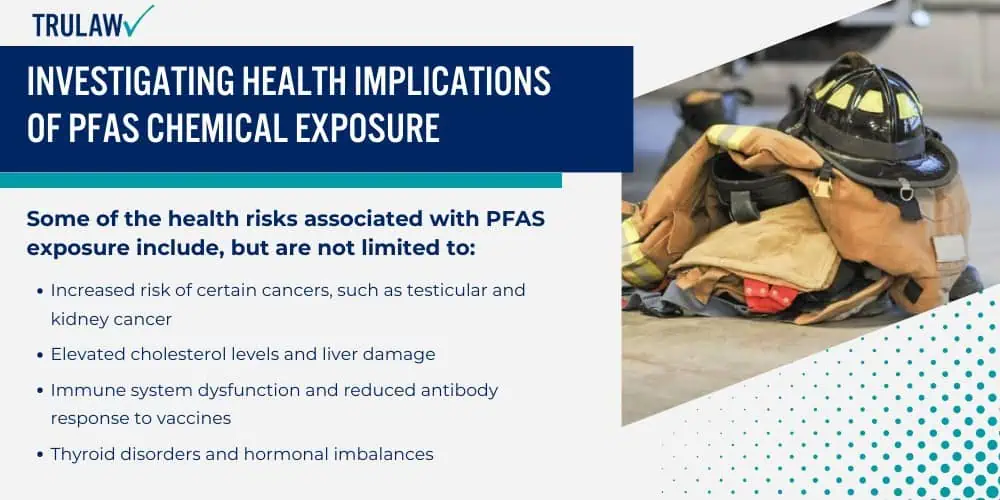
The PFAS firefighting gear ban is crucial to protecting the health and safety of fire service men and women nationwide.
Importance of Eliminating PFAS from Firefighting Gear
Eliminating PFAS from firefighting gear is essential for protecting the health and well-being of firefighters, who are at a higher risk of exposure due to the nature of their work.
Firefighters are exposed to PFAS through various pathways, including inhalation, ingestion, and dermal absorption, which can lead to a range of adverse health effects.
Studies have shown that firefighters have higher levels of PFAS in their blood compared to the general population, highlighting the need for action to reduce their exposure.
Eliminating PFAS from firefighting gear can significantly reduce the risks associated with these chemicals and ensure a safer working environment for our first responders.
Health Risks Linked to PFAS in Firefighting Gear
Exposure to PFAS has been linked to various health risks, particularly concerning for firefighters who are regularly exposed to these chemicals through their gear and equipment.
Some of the health risks associated with PFAS exposure include, but are not limited to:
- Increased risk of certain cancers, such as testicular and kidney cancer
- Elevated cholesterol levels and liver damage
- Immune system dysfunction and reduced antibody response to vaccines
- Thyroid disorders and hormonal imbalances
- Pregnancy complications and developmental issues in children
These health risks underscore the importance of eliminating PFAS from firefighting gear and finding safer alternatives to protect the health of our firefighters.
Tru Law is dedicated to advocating for the rights of firefighters affected by PFAS exposure and ensuring they receive the support and compensation they deserve.
Reasons Behind the PFAS Firefighting Gear Ban
The PFAS firefighting gear ban is driven by scientific evidence and public health concerns.
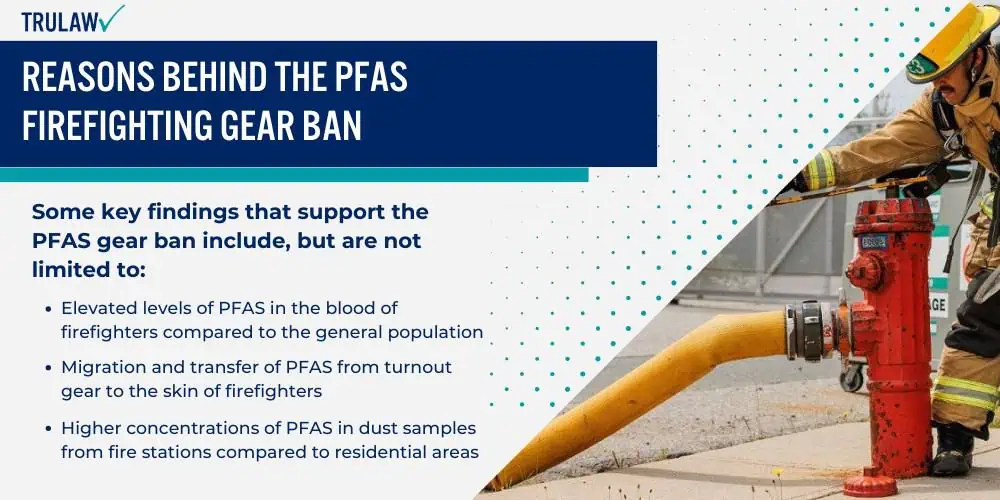
This section will explore the key factors that have led to the push for eliminating PFAS from firefighting gear.
Scientific Evidence Supporting the PFAS Gear Ban
The PFAS firefighting gear ban is supported by a growing body of scientific evidence that highlights the health risks associated with PFAS exposure.
Numerous studies have investigated the presence of PFAS in firefighting gear and the potential consequences of exposure to these chemicals.
Some key findings that support the PFAS gear ban include, but are not limited to:
- Elevated levels of PFAS in the blood of firefighters compared to the general population
- Migration and transfer of PFAS from turnout gear to the skin of firefighters
- Higher concentrations of PFAS in dust samples from fire stations compared to residential areas
- Potential for dermal absorption of PFAS from contaminated gear and equipment
This scientific evidence has played a crucial role in promoting the ban on PFAS firefighting gear and highlighting the need for safer alternatives.
Public Health Concerns and Advocacy for the Ban
Public health concerns have been a major driving force behind the PFAS firefighting gear ban.
As awareness of the health risks associated with PFAS exposure has grown, firefighters, unions, and public health advocates have called for action to protect the health of first responders.
Advocacy efforts have included, but are not limited to:
- Lobbying for legislation to ban PFAS in firefighting gear
- Raising awareness about the health risks of PFAS exposure among firefighters and the public
- Collaborating with researchers to investigate the extent of PFAS contamination in firefighting equipment
- Encouraging the development and adoption of PFAS-free alternatives
These efforts have been instrumental in building support for the PFAS firefighting gear ban and ensuring that firefighters’ health and safety remain a top priority.
Tru Law has been at the forefront of these advocacy efforts, working tirelessly to protect the rights of firefighters affected by PFAS exposure.
Current Regulations and Policies on PFAS Gear
Current regulations and policies on PFAS gear vary across jurisdictions, but there is a growing trend towards restricting or banning the use of these chemicals in firefighting equipment.
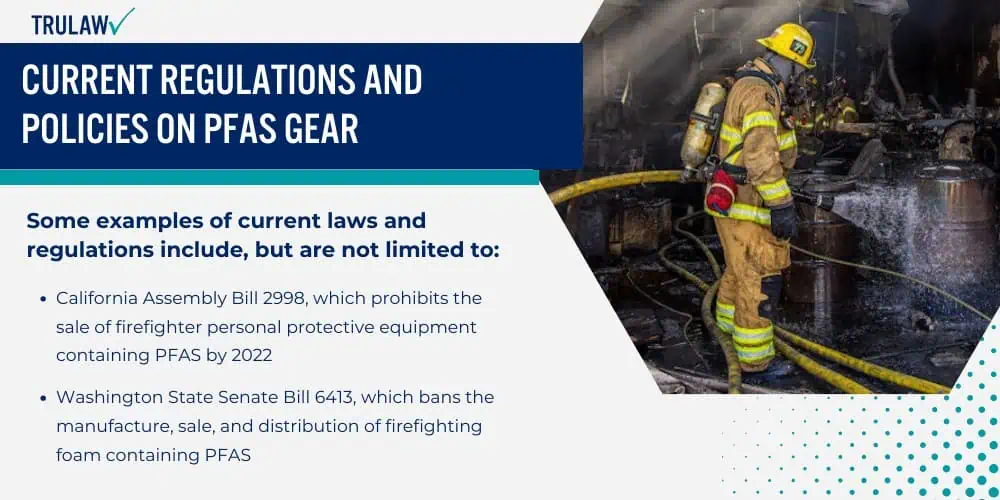
This section will explore the existing laws and regulations governing PFAS in firefighting gear and the key organizations advocating for change.
Laws and Regulations Governing PFAS in Firefighting Gear
Several states and jurisdictions have already taken steps to regulate PFAS in firefighting gear, paving the way for a more comprehensive ban.
Some examples of current laws and regulations include, but are not limited to:
- California Assembly Bill 2998, which prohibits the sale of firefighter personal protective equipment containing PFAS by 2022
- Washington State Senate Bill 6413, which bans the manufacture, sale, and distribution of firefighting foam containing PFAS
- The European Union’s Registration, Evaluation, Authorization, and Restriction of Chemicals (REACH) regulation, which restricts the use of certain PFAS in products
These laws and regulations demonstrate a growing recognition of the need to address PFAS contamination in firefighting equipment and provide a foundation for more comprehensive action.
Key Organizations and Advocates for PFAS-Free Gear
Several organizations and advocates have been at the forefront of the movement to eliminate PFAS from firefighting gear.
Some key players include, but are not limited to:
- The International Association of Fire Fighters (IAFF), which has advocated for PFAS-free gear and supported research on the health impacts of PFAS exposure
- The Environmental Protection Agency (EPA), has taken steps to regulate PFAS and investigate their presence in firefighting foam
- The National Fire Protection Association (NFPA), which has been working to update its standards for firefighting gear to address PFAS contamination
- Environmental and public health organizations, such as the Environmental Working Group and the Green Science Policy Institute, have raised awareness about the risks of PFAS and advocated for their elimination
These organizations and advocates have played a crucial role in driving the conversation around PFAS in firefighting gear and pushing for meaningful action to protect firefighters’ health.
Tru Law has been working closely with these organizations to ensure that the voices of affected firefighters are heard and that their rights are protected.
Challenges Implementing the PFAS Firefighting Gear Ban
Implementing the PFAS firefighting gear ban comes with several challenges that must be addressed to ensure a smooth transition to safer alternatives.
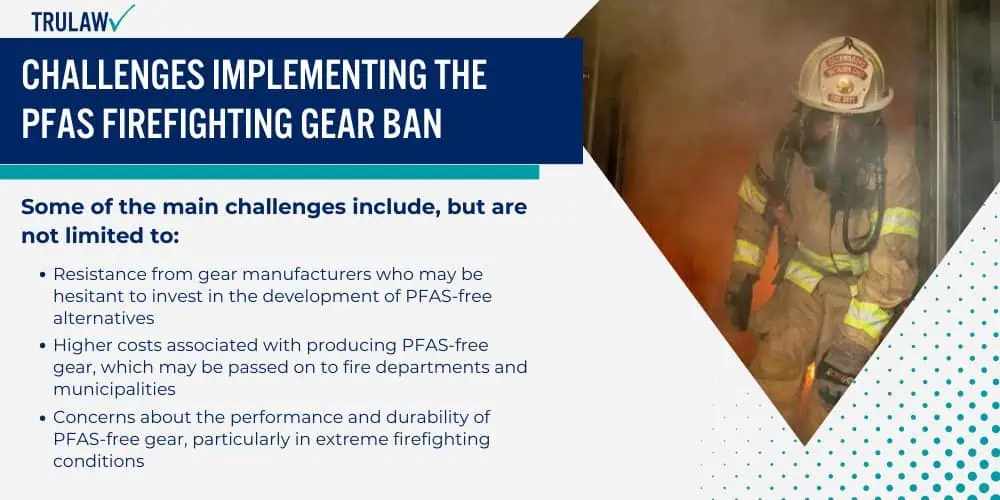
This section will explore the barriers to removing PFAS from firefighting gear and the technological challenges in developing effective PFAS-free options.
Barriers to Removing PFAS from Firefighting Gear
While the PFAS firefighting gear ban is a necessary step towards protecting the health of firefighters, implementing the ban comes with several challenges and barriers.
Some of the main challenges include, but are not limited to:
- Resistance from gear manufacturers who may be hesitant to invest in the development of PFAS-free alternatives
- Higher costs associated with producing PFAS-free gear, which may be passed on to fire departments and municipalities
- Concerns about the performance and durability of PFAS-free gear, particularly in extreme firefighting conditions
- Limited availability of PFAS-free options that meet current safety standards and requirements
Addressing these barriers will require collaboration among gear manufacturers, researchers, and firefighting organizations to develop effective and affordable PFAS-free solutions.
Technological Challenges in Developing PFAS Alternatives
Developing PFAS-free alternatives for firefighting gear that meet the same performance standards as PFAS-containing gear is a significant technological challenge.
Some of the key issues that must be addressed include, but are not limited to:
- Identifying materials that can provide the same level of water repellency, stain resistance, and durability as PFAS
- Ensuring that PFAS-free alternatives can withstand the extreme heat and physical demands of firefighting
- Developing manufacturing processes that are compatible with PFAS-free materials and can produce gear at scale
- Conducting rigorous testing and evaluation to ensure that PFAS-free gear meets all necessary safety standards
Overcoming these technological challenges will require significant investment in research and development and collaboration among gear manufacturers, material scientists, and firefighting experts.
Tru Law is committed to supporting these efforts and advocating for developing safer, PFAS-free alternatives for firefighting gear.
Exploring Alternatives to PFAS in Firefighting Gear
As the PFAS firefighting gear ban takes effect, it is crucial to explore viable alternatives that can provide the same level of protection without the associated health risks.
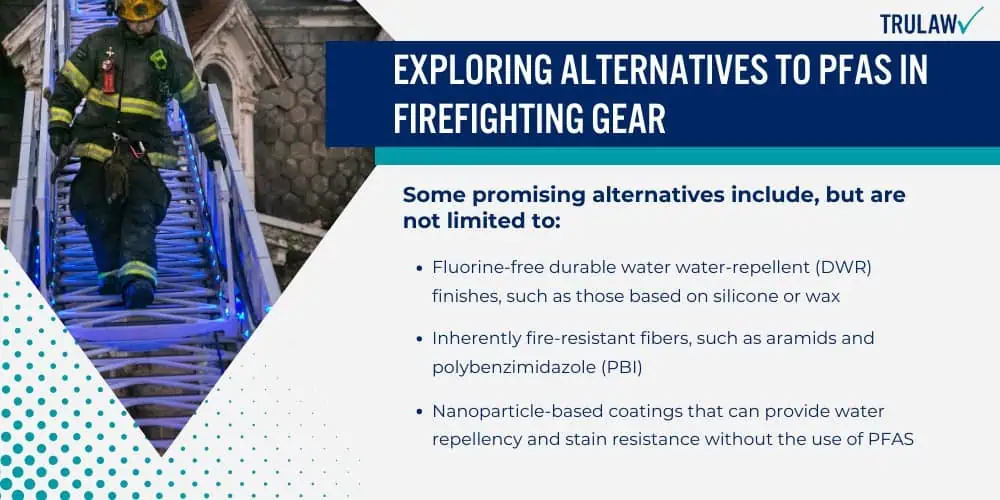
This section will discuss non-PFAS materials and technologies for firefighting gear and highlight case studies of successful PFAS-free gear adoption.
Non-PFAS Materials and Technologies for Firefighting Gear
As the push to eliminate PFAS from firefighting gear gains momentum, researchers and manufacturers are exploring a range of non-PFAS materials and technologies that could provide the same level of protection and performance.
Some promising alternatives include, but are not limited to:
- Fluorine-free durable water water-repellent (DWR) finishes, such as those based on silicone or wax
- Inherently fire-resistant fibers, such as aramids and polybenzimidazole (PBI)
- Nanoparticle-based coatings that can provide water repellency and stain resistance without the use of PFAS
- Advanced membrane technologies that can provide breathability and moisture management while maintaining water-repellency
While these alternatives show promise, further research and development are needed to ensure they can meet the rigorous performance and safety requirements of firefighting gear.
Case Studies of Successful PFAS-Free Firefighting Gear
Despite the challenges in developing PFAS-free firefighting gear, some manufacturers and fire departments have already made significant progress in adopting PFAS-free alternatives.
Some notable case studies include, but are not limited to:
- The San Francisco Fire Department has been working with manufacturers to develop and test PFAS-free turnout gear
- The Seattle Fire Department has committed to phasing out PFAS-containing gear and adopting PFAS-free alternatives
- Manufacturers such as TenCate Protective Fabrics and Lion, have developed PFAS-free gear using alternative materials and technologies
These case studies demonstrate that it is possible to develop and adopt PFAS-free firefighting gear that meets the necessary performance and safety standards, and they provide valuable lessons for other departments and manufacturers looking to make the transition.
Impact of the PFAS Firefighting Gear Ban
The PFAS firefighting gear ban will have significant implications for the health and safety of firefighters, as well as their experiences with new PFAS-free equipment.
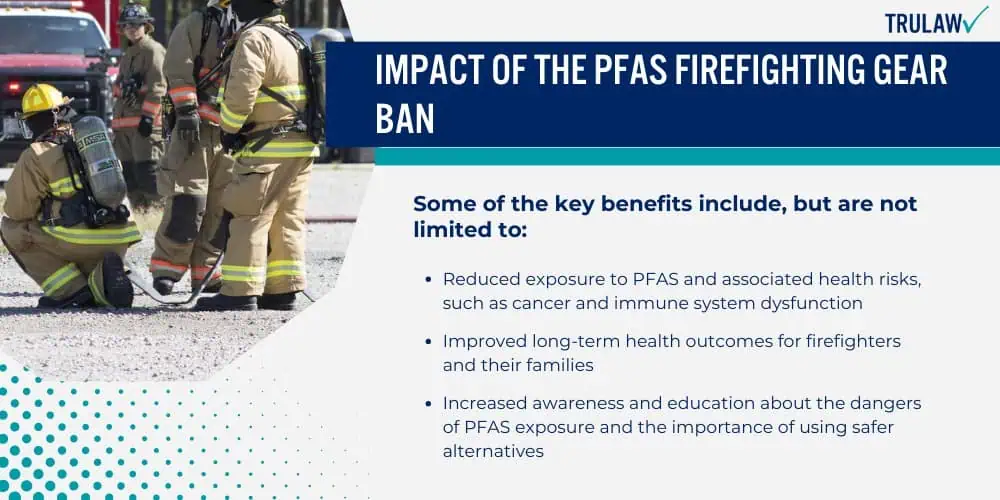
This section will explore the ban’s effects on firefighter safety and health and discuss firefighters’ perspectives and experiences with PFAS-free gear.
Effects of the Ban on Firefighter Safety and Health
The PFAS firefighting gear ban is expected to have significant positive impacts on the safety and health of firefighters.
Some of the key benefits include, but are not limited to:
- Reduced exposure to PFAS and associated health risks, such as cancer and immune system dysfunction
- Improved long-term health outcomes for firefighters and their families
- Increased awareness and education about the dangers of PFAS exposure and the importance of using safer alternatives
- Encouragement for manufacturers to invest in the development of PFAS-free gear and technologies
While transitioning to PFAS-free gear may present some initial challenges, the long-term benefits for firefighter health and safety are clear and compelling.
Tru Law supports firefighters throughout this transition and protects their rights and well-being.
Firefighter Perspectives and Experiences with PFAS-Free Gear
As more fire departments begin to adopt PFAS-free gear, it is important to consider the perspectives and experiences of firefighters using this new equipment.
Some key issues that firefighters may face include, but are not limited to:
- Concerns about the performance and durability of PFAS-free gear, particularly in extreme firefighting conditions
- Challenges in adapting to new materials and technologies that may have different feel or performance characteristics
- Questions about the long-term effectiveness and safety of PFAS-free alternatives
- Needs for additional training and education on the proper use and maintenance of PFAS-free gear
Addressing these concerns and ensuring that firefighters have the support and resources they need to use PFAS-free gear effectively will be critical to the success of the PFAS firefighting gear ban.
Future Directions for PFAS-Free Firefighting Gear
As the PFAS firefighting gear ban takes effect, it is important to consider future research, development, and policy directions to ensure the continued protection of firefighter health and safety.
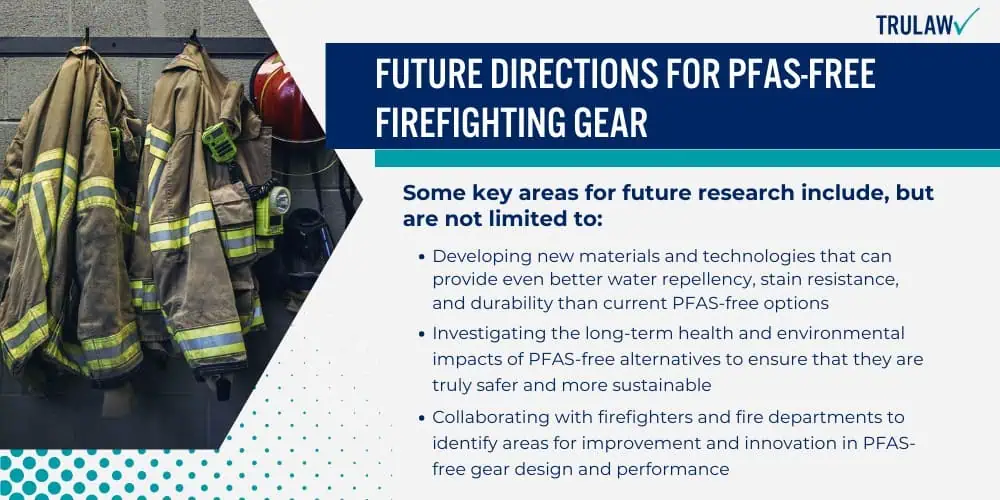
This section will explore the ongoing research and development of safer firefighting gear and discuss potential future policies and regulations on PFAS.
Research and Development of Safer Firefighting Gear
As the PFAS firefighting gear ban takes effect, it is important to continue investing in research and development to improve the safety and performance of PFAS-free alternatives.
Some key areas for future research include, but are not limited to:
- Developing new materials and technologies that can provide even better water repellency, stain resistance, and durability than current PFAS-free options
- Investigating the long-term health and environmental impacts of PFAS-free alternatives to ensure that they are truly safer and more sustainable
- Collaborating with firefighters and fire departments to identify areas for improvement and innovation in PFAS-free gear design and performance
- Exploring ways to reduce the cost and improve the accessibility of PFAS-free gear for fire departments of all sizes and budgets
By continuing to invest in research and development, we can ensure that firefighters have access to the safest and most effective gear possible without the risks associated with PFAS exposure.
Potential Future Policies and Regulations on PFAS
While the PFAS firefighting gear ban is an important step towards protecting firefighters’ health, additional policies and regulations are likely to be needed to address the risks of PFAS exposure fully.
Some potential future policies and regulations could include, but are not limited to:
- Expanding the ban on PFAS in firefighting gear to include other types of personal protective equipment (PPE) and firefighting foam
- Establishing more stringent standards for the testing and certification of PFAS-free gear to ensure that it meets the necessary performance and safety requirements
- Providing funding and support for fire departments to transition to PFAS-free gear and dispose of PFAS-containing equipment safely
- Strengthening regulations on the production, use, and disposal of PFAS in other industries to reduce overall environmental contamination and exposure risks
By taking a comprehensive approach to addressing PFAS contamination, we can create a safer and healthier future for firefighters and communities worldwide.
Tru Law: The #1 PFAS Firefighting Gear Lawyer
The PFAS firefighting gear ban represents a significant milestone in protecting the health and safety of firefighters, but it is only the beginning of a longer journey toward a PFAS-free future for firefighting.
This section will summarize the importance of the PFAS gear ban and offer final thoughts on achieving a PFAS-free future for firefighters.
Summarizing the Importance of a PFAS Firefighting Gear Ban
The PFAS firefighting gear ban is a critical step towards protecting the health and safety of firefighters who put their lives on the line daily to serve their communities.
By eliminating PFAS from firefighting equipment, we can reduce the risks of cancer, immune system dysfunction, and other serious health problems associated with PFAS exposure.
While implementing the ban comes with challenges, including technological barriers and resistance from some manufacturers, the benefits for firefighter health and safety are clear and compelling.
The case studies of successful PFAS-free gear adoption and the ongoing research and development of safer alternatives demonstrate that a PFAS-free future for firefighting is possible and necessary.
Final Thoughts on Achieving a PFAS-Free Future for Firefighters
Achieving a PFAS-free future for firefighting will require ongoing collaboration, innovation, and commitment from all stakeholders, including firefighters, fire departments, gear manufacturers, researchers, and policymakers.
By working together to overcome the challenges and barriers to PFAS-free gear adoption, we can ensure that firefighters have access to the safest and most effective equipment possible.
As we move forward, it is important to prioritize the health and well-being of firefighters above all else.
The PFAS firefighter gear ban is an important step in the right direction, but it is only the beginning of a longer journey toward a safer and more sustainable future for firefighting.
By continuing to invest in research, development, and education and advocating for stronger policies and regulations to address PFAS contamination, we can create a world where firefighters can serve their communities without risking their health.
The path to PFAS-free firefighting may be challenging, but it is a path we must take to protect those who protect us every day.
Firefighter Turnout Gear Lawsuit Frequently Asked Questions
-
While efforts are underway to develop PFAS-free gear, no viable alternatives currently meet the necessary safety standards set by the National Fire Protection Association.
-
The amount of PFAS present varies widely across different types of personal protective equipment (PPE), also called turnout gear.
Studies conducted by the National Institute of Standards and Environmental Protection Agency have found the highest concentrations in the gear’s moisture barrier layer.
-
Firefighter’s protective clothing includes more PFAS exposure than the general population.
This can increase the risk of certain cancers, immune system dysfunction, and other health issues.
Addressing all the other hazards firefighters encounter while also working to reduce PFAS exposure is crucial.
-
The National Institute of Standards and other organizations are working to develop and test PFAS-free alternatives for firefighting gear.
Advocacy groups are raising awareness about the health risks of PFAS chemicals in personal protective gear, sometimes called turnout gear.
-
In addition to their gear, firefighters may be exposed to PFAS through firefighting foams and contaminated water at fire sites.
PFAS can also be found in everyday products such as food packaging, non-stick cookware, and stain-resistant fabrics.

Managing Attorney & Owner
With over 25 years of legal experience, Jessica Paluch-Hoerman is an Illinois lawyer, a CPA, and a mother of three. She spent the first decade of her career working as an international tax attorney at Deloitte.
In 2009, Jessie co-founded her own law firm with her husband – which has scaled to over 30 employees since its conception.
In 2016, Jessie founded TruLaw, which allows her to collaborate with attorneys and legal experts across the United States on a daily basis. This hypervaluable network of experts is what enables her to share the most reliable, accurate, and up-to-date legal information with our readers!
Additional Firefighter Turnout Gear Lawsuit resources on our website:
Here, at TruLaw, we’re committed to helping victims get the justice they deserve.
Alongside our partner law firms, we have successfully collected over $3 Billion in verdicts and settlements on behalf of injured individuals.
Would you like our help?
At TruLaw, we fiercely combat corporations that endanger individuals’ well-being. If you’ve suffered injuries and believe these well-funded entities should be held accountable, we’re here for you.
With TruLaw, you gain access to successful and seasoned lawyers who maximize your chances of success. Our lawyers invest in you—they do not receive a dime until your lawsuit reaches a successful resolution!
AFFF Lawsuit claims are being filed against manufacturers of aqueous film-forming foam (AFFF), commonly used in firefighting.
Claims allege that companies such as 3M, DuPont, and Tyco Fire Products failed to adequately warn users about the potential dangers of AFFF exposure — including increased risks of various cancers and diseases.
Depo Provera Lawsuit claims are being filed by individuals who allege they developed meningioma (a type of brain tumor) after receiving Depo-Provera birth control injections.
A 2024 study found that women using Depo-Provera for at least 1 year are five times more likely to develop meningioma brain tumors compared to those not using the drug.
Suboxone Tooth Decay Lawsuit claims are being filed against Indivior, the manufacturer of Suboxone, a medication used to treat opioid addiction.
Claims allege that Indivior failed to adequately warn users about the potential dangers of severe tooth decay and dental injuries associated with Suboxone’s sublingual film version.
Social Media Harm Lawsuits are being filed against social media companies for allegedly causing mental health issues in children and teens.
Claims allege that companies like Meta, Google, ByteDance, and Snap designed addictive platforms that led to anxiety, depression, and other mental health issues without adequately warning users or parents.
Transvaginal Mesh Lawsuits are being filed against manufacturers of transvaginal mesh products used to treat pelvic organ prolapse (POP) and stress urinary incontinence (SUI).
Claims allege that companies like Ethicon, C.R. Bard, and Boston Scientific failed to adequately warn about potential dangers — including erosion, pain, and infection.
Bair Hugger Warming Blanket Lawsuits involve claims against 3M — alleging their surgical warming blankets caused severe infections and complications (particularly in hip and knee replacement surgeries).
Plaintiffs claim 3M failed to warn about potential risks — despite knowing about increased risk of deep joint infections since 2011.
Baby Formula NEC Lawsuit claims are being filed against manufacturers of cow’s milk-based baby formula products.
Claims allege that companies like Abbott Laboratories (Similac) and Mead Johnson & Company (Enfamil) failed to warn about the increased risk of necrotizing enterocolitis (NEC) in premature infants.
Here, at TruLaw, we’re committed to helping victims get the justice they deserve.
Alongside our partner law firms, we have successfully collected over $3 Billion in verdicts and settlements on behalf of injured individuals.
Would you like our help?
